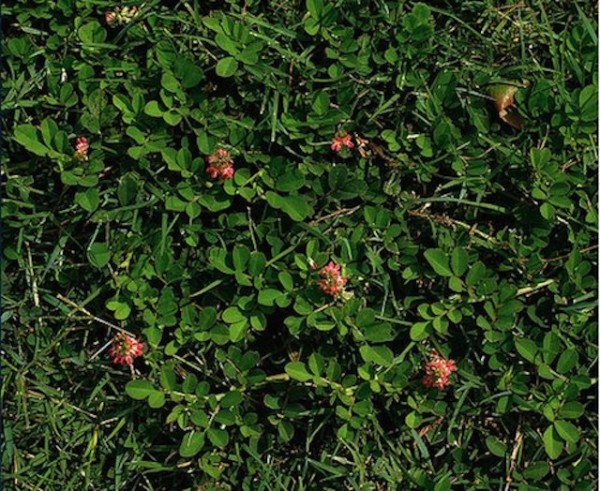Danger in the Grass: Florida Horses at Risk in Pastures Invaded by Creeping Indigo Weed
- March 10, 2017
- ⎯ Equus

It’s the time of year when horse owners are inspecting new hay shipments and planning winter nutrition needs for their horses. But in some parts of the country, they also need to be vigilant about the pastures where their horses graze as winter approaches. Drought in the Northeast and excessive rain in the Southeast have heralded a succession of invasive and opportunistic plants into horse pastures from Maine to Florida.
Horse owners should be on the lookout for changes in the typical range of plants found in pastures. In drought areas, there may be fewer plants this year, with more dirt exposed, but opportunistic, drought-tolerant weeds may have invaded over the summer. In wetter climates, the problem might be the opposite, as multiple species compete to gain a foothold in the moist soil.
Of special concern is creeping indigo (Indigofera spicata), a common weed in Florida. It carries an elevated health risk to horses after this year’s wet summer and is a concern to veterinarians in the state who fear more horses may be affected by grazing on this plant that many horse owners overlook on their property.

The veterinarians at Palm Beach Equine Clinic in Wellington, Florida caution horse owners of recent toxicity cases that have arisen in South Florida suspected by the low-growing weed. Although creeping indigo is not native to Florida, it has been reportedly growing in the state since the 1920s. The plant has recently spread from the past summer’s humid conditions.
Most toxic plants are not palatable to horses and therefore do not pose as much risk; however, it appears that horses are eating creeping indigo with suspected fatal effects. The only real treatment is to recognize and remove the poisonous plant from all grazing areas.
Palm Beach Equine Clinic’s Dr. Kathleen Timmins explained that veterinarians in South Florida are suspecting creeping indigo cases more often and in more places than ever before. Many people are unaware of the problems this toxic plant can cause.
“Toxicity from creeping indigo can present itself through a number of different symptoms, which can make it difficult to recognize and definitively diagnose,” Dr. Timmins noted. “There is no test or treatment, and the damage that it causes can be irreversible. The only true treatment is limiting their exposure to it.”
The most important step to avoid illness is to eradicate the plant from all pastures and grazing areas. Horse owners should walk through their properties and review grass areas for the plant. Creeping indigo is a prostrate (low-growing or horizontally-spreading) plant that is commonly found in high traffic areas of grass, such as parking lots, turf, roadsides, medians, and overgrazed pastures.
Flowers arise from the base of the leaves and are pink to salmon in color. It often grows under the grass, and when it is not flowering, it can be difficult to see. It also has a very deep root, so it is not easy to pull up.
Both neurologic and non-neurologic signs are documented, and researchers are uncertain how much creeping indigo a horse needs to consume before clinical signs appear.
The most notable signs are neurologic; horses may seem lethargic or have less energy than usual. Head carriage is often low, and there may be rhythmic blinking and jerking eye movements. An abnormal gait may be noticed, characterized by incoordination and weakness in all limbs.
Non-neurologic signs may include high heart and respiratory rates, high temperature, watery discharge from the eyes, discoloration of the cornea or corneal ulceration, or ulceration of the tongue and gums.
“There are so many varied symptoms that it is often not the first diagnosis you would think of,” Dr. Timmins explained. “There are also many other toxic plants, but if horses have access to good quality feed or grazing, they will not usually eat the toxic plants. The best solution is to find the plant, get rid of it, and not have to find out if it has been consumed.”
Horses that are quickly removed from the plants may recover completely, but there is no effective treatment, and symptoms may persist. The best way to prevent poisoning is to stop access to paddocks where creeping indigo is present and to remove plants by physical means or herbicide application.
If you live in South Florida: Palm Beach Equine Clinic suggests that horse owners check their paddocks and grazing areas prior to use. For more information, call the clinic.
To learn more:
Creeping Indigo, A Poisonous Plant of Concern in Florida Pastures by Robert MacKay, Ed Jennings, Brent Sellers, Jason Ferrell, and Amanda House for the Agronomy Department, University of Florida Institute of Food and Agricultural Sciences Extension (2015)
Indigofera spicata (creeping indigo) poisoning of three ponies. Ossedryver, S., Baldwin, G., Stone, B., McKenzie, R., van Eps, A., Murray, S. and Fletcher, M. (2013), Australian Veterinary Journal, 91: 143–149.
Top photo by Pete Markham (thanks!).





